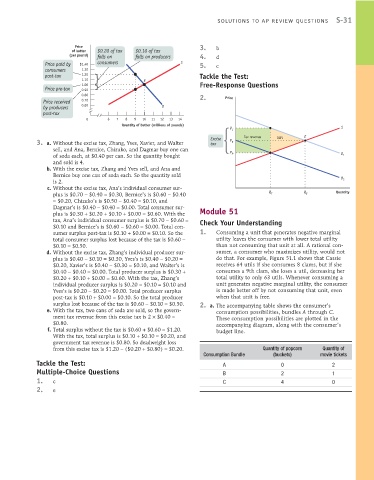Page 877 - Krugmans Economics for AP Text Book_Neat
P. 877
S-31
SOLUTIONS TO AP REVIEW QUESTIONS
Price 3. b
of butter $0.20 of tax $0.10 of tax
(per pound) falls on falls on producers 4. d
Price paid by $1.40 consumers S 5. c
consumers 1.30
post-tax 1.20 Tackle the Test:
1.10 E
1.00 Free-Response Questions
Price pre-tax 0.90
0.80 2. Price
Price received 0.70
by producers 0.60 D
post-tax
0 6 7 8 9 10 11 12 13 14
Quantity of butter (millions of pounds)
P S
C
Tax revenue E
Excise P DWL
3. a. Without the excise tax, Zhang, Yves, Xavier, and Walter tax E
sell, and Ana, Bernice, Chizuko, and Dagmar buy one can
P
of soda each, at $0.40 per can. So the quantity bought P D 1
and sold is 4.
b. With the excise tax, Zhang and Yves sell, and Ana and
Bernice buy one can of soda each. So the quantity sold
D 2
is 2.
c. Without the excise tax, Ana’s individual consumer sur-
Q Q Quantity
plus is $0.70 − $0.40 = $0.30, Bernice’s is $0.60 − $0.40 T E
= $0.20, Chizuko’s is $0.50 − $0.40 = $0.10, and
Dagmar’s is $0.40 − $0.40 = $0.00. Total consumer sur- Module 51
plus is $0.30 + $0.20 + $0.10 + $0.00 = $0.60. With the
tax, Ana’s individual consumer surplus is $0.70 − $0.60 = Check Your Understanding
$0.10 and Bernice’s is $0.60 − $0.60 = $0.00. Total con-
sumer surplus post-tax is $0.10 + $0.00 = $0.10. So the 1. Consuming a unit that generates negative marginal
total consumer surplus lost because of the tax is $0.60 − utility leaves the consumer with lower total utility
$0.10 = $0.50. than not consuming that unit at all. A rational con-
d. Without the excise tax, Zhang’s individual producer sur- sumer, a consumer who maximizes utility, would not
plus is $0.40 − $0.10 = $0.30, Yves’s is $0.40 − $0.20 = do that. For example, Figure 51.1 shows that Cassie
$0.20, Xavier’s is $0.40 − $0.30 = $0.10, and Walter’s is receives 64 utils if she consumes 8 clams, but if she
$0.40 − $0.40 = $0.00. Total producer surplus is $0.30 + consumes a 9th clam, she loses a util, decreasing her
$0.20 + $0.10 + $0.00 = $0.60. With the tax, Zhang’s total utility to only 63 utils. Whenever consuming a
individual producer surplus is $0.20 − $0.10 = $0.10 and unit generates negative marginal utility, the consumer
Yves’s is $0.20 − $0.20 = $0.00. Total producer surplus is made better off by not consuming that unit, even
post-tax is $0.10 + $0.00 = $0.10. So the total producer when that unit is free.
surplus lost because of the tax is $0.60 − $0.10 = $0.50. 2. a. The accompanying table shows the consumer’s
e. With the tax, two cans of soda are sold, so the govern- consumption possibilities, bundles A through C.
ment tax revenue from this excise tax is 2 × $0.40 = These consumption possibilities are plotted in the
$0.80. accompanying diagram, along with the consumer’s
f. Total surplus without the tax is $0.60 + $0.60 = $1.20. budget line.
With the tax, total surplus is $0.10 + $0.10 = $0.20, and
government tax revenue is $0.80. So deadweight loss
from this excise tax is $1.20 − ($0.20 + $0.80) = $0.20. Quantity of popcorn Quantity of
Consumption Bundle (buckets) movie tickets
Tackle the Test: A 0 2
Multiple-Choice Questions B 2 1
1. c C 4 0
2. e

